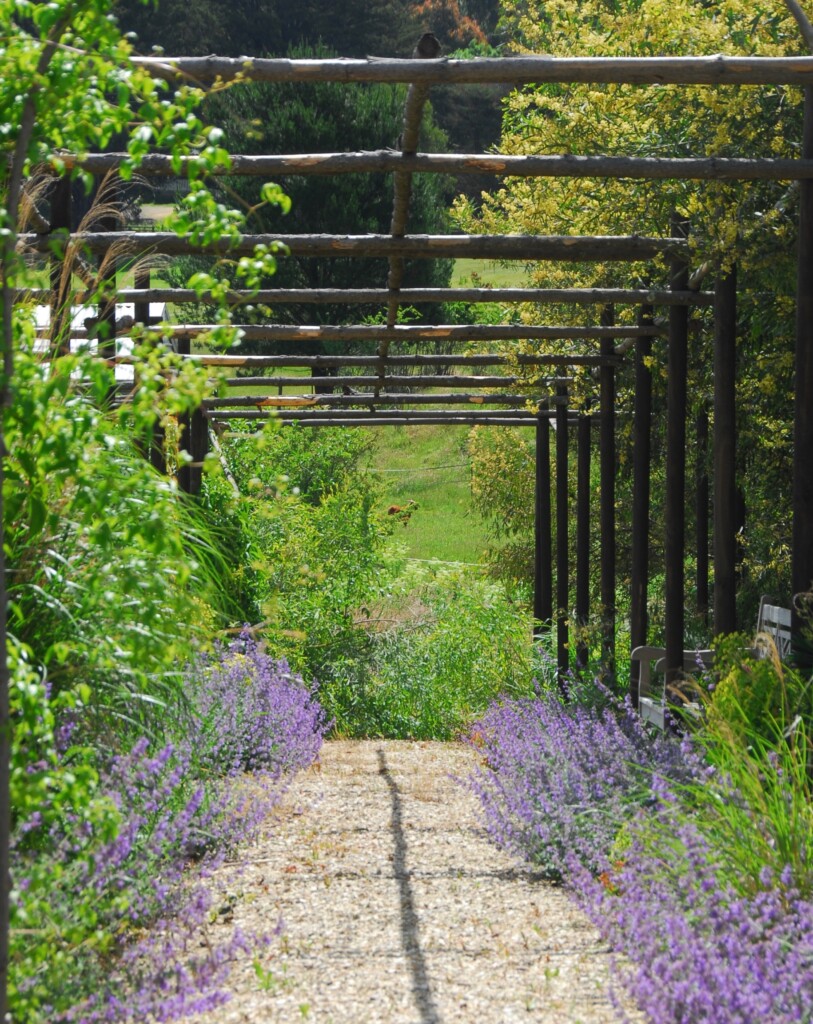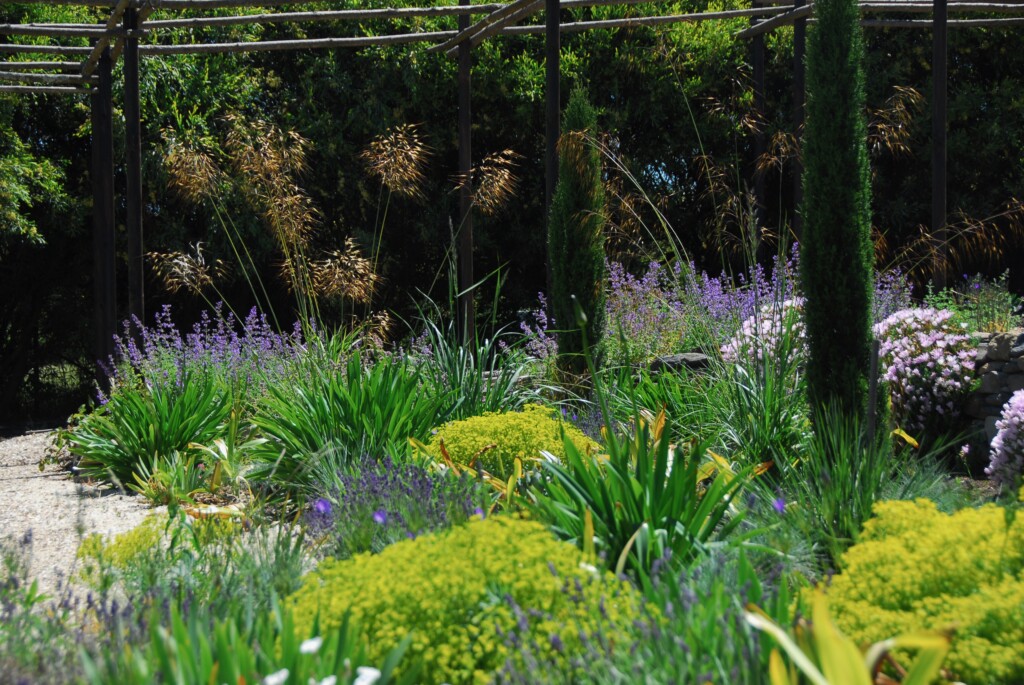Were you gardening in the days before Nepeta ‘Six Hills Giant’ became available in Australia? I remember poring over British garden books, and yearning – like actually aching – to be able to get my hands on it. I recall one pic in particular, showing a bench surrounded by an arc of Nepeta ‘Six Hill’s Giant’. It was as if the bench was floating in a low fog – a hovering haze – of lavender-blue.
Now I’ve lived with it for 25 years or so, my love is somewhat moderated. I still consider it a great plant, but am as aware of its limitations as I am of its charms.

To cover it’s charms first, that haze of lavender-blue is as heartbreakingly lovely as ever it was, stretching up to nearly one metre tall in a really well fed plant, but averaging about 70cm. And it’s as generous as it is lovely, with an initial long flowering period starting (for me) about now. If I then cut it back quite hard (right back into the older foliage – not just dead-heading it) it’ll do a second, rather diminished flowering later. Where there’s a longer growing season, and water for irrigation, some claim to get three flowering cycles out of it.
The other great advantage of Nepeta ‘Six Hills Giant’ (and it was writing about this aspect re: Geums last week that prompted this post) is the huge potential spread of each plant. Not trusting my guess that a single particularly vigorous plant must have achieved 1.5m across, I once grabbed a tape and actually measured the thing, only to find that it covered a circle 2.1 m across, and this from a growing crown no more than 30-40cm across. This is an increase from about 0.12 sq m to 3.5sq m of coverage between winter and late spring, only to return back to the crown again each winter. That makes for fabulous ground-cover capability – particularly in a new garden when you’re in a hurry for growth, or below plants like roses, as one plant of Nepeta ‘Six Hills Giant’ every 1.5m could (depending on growing conditions) be plenty to achieve a solid carpet at flowering time. Indeed, it’s the most perfect plant for beneath roses, as their initial and heaviest flowering coincides perfectly, and there’s not a rose (with the exception, perhaps, of those pretend-blue ones) whose colour isn’t complemented by the nearby blue of the catmint.

But this extravagant spread becomes the biggest challenge to its use in other settings. It’s a tricky plant to mix in with other perennials, as the great bulk of foliage and flower seasonally swamps everything surrounding it. If used next to paths or lawns (as its low-lying profile suggests), it spills so far over them as to make them virtually impassable, unless planted well away from the edge. I have some plants that have found themselves growing right next to a rapidly increasing clump of Tulipa saxatilis. Placed appropriately, they might prove to be perfect companions, with the tulip arising in bare soil, and its space then being swallowed up by the catmint as the tulip dies down. The trouble is that they’re just too closely planted, and the catmint wants to subsume the tulip when it’s still in full leaf. The width of the bed doesn’t allow the outworking of the most obvious solution ie moving the catmint further away so that it doesn’t reach the tulip until it has died down sufficiently, so I revert to the other very workable solution, and that is to cut the new catmint growth back hard before it grows over the tulip, and by the time it recovers – which it does, fully, and without apparent discouragement – the tulip has completed its life-cycle. So while it’s over-enthusiasm can be a challenge, it’s infinitely manageable.

Better still, you pick your giant catmint form according to its purpose. If you’re wanting to cover huge areas of ground beneath roses, go for ‘Six Hills’. If you’re mixing with other perennials, go for a less lax form, like ‘Walker’s Low’ (sold in Australia as ‘Walker’s Blue’).
Yet another post that makes me think Michael is the most readable garden writer in the world today – inspiring, informative and truthful and with a love of words as strong as his love of plants and beauty. All hail, Michael McCoy!
Oh man, you’re inducing some serious performance anxiety!!
Agreed, hurry up and write a book Michael! There’s no way its not a best seller 😛
I like the ‘Otway Towers’ from Lambley for a more upright form that doesn’t collapse at peak blue! Mind you with the amount of rain we’ve had in Hobart my Towers are threatening to fall!
Australia needs it’s own Beth Chatto – someone who is not happy unless they’ve got every known form growing (of every plant in their category of choice) in one location, thus providing comparative opportunities for all we gardeners who want to pick the most appropriate variety for any garden role we’re trying to fill. How good would that be??
I’ve had catmint in my garden for years but no idea what type as it came as divisions from a friends garden.
I have a love hate relationship with it as it really only looks in peak form right now when it’s blue flowers stand erect and the foliage is fresh. I’ve found cutting back after the first flush is ok but by then the old flowers are lying flopped all over the place tangled up in each other and the foliage is tired and grey. The second flush is never as good. Then winter cut back leaves nothing to be seen at all for months on end.
I’m not sure I’d plant it again.
Michael, Thanks.
You’ve just given me the solution. I needed for a real problem area in my garden, how to dress a front fence. I think it will blend beautifully with my old world Albertine rambling rose vine.
Any tips where I can buy the best examples of this beauty.
I have such a love-hate relationship with this plant. When it’s good it’s really good, but when it’s bad it’s terrible.
The amount of hacking it seems to need to stop it getting that dead-in-the-middle thing later in the season usually robs it of a second flowering for me. I know it’s a sunlight issue, it insists on huge amounts to keep looking good, I just wish it could tolerate a little less sun and still look as peppy. Its usefulness to me would increase markedly.
I always jettison the ‘it’s still contributing something’ methodology shortly after thinking it and opt instead for a smashing cut back. If it flowers again, great, if not, them’s the breaks. It’s a tough customer, without a doubt. Agree that it’s a great companion to roses, especially the standards, whose bare legs never fail to grate on my mind. This plant covers up the bare legs nicely at puts my head at ease.
I’m a huge fan of Nepeta (all varieties) but you’ve just hit the nail on the head with “six hills giant”, it flips everywhere (still looks fabulous) & I end up having to mow it away from my garden edges, I must have planted them way too close!
After meandering my way through this post, I am wishing I had read it a few weeks ago, having just planted out my Nepeta, too many, too close. Gardening for me has predominantly been ‘learning by experimentation’, I find something I like and I plant it and then afterwards, seek more information, often resulting in lots of back peddling. I agree Michael should write a book, especially for people like me. I need to remember to research before buying, and especially before planting. I am a notorious over planter, and yet somehow it eventually comes together in a wild rambling way. At least now I have a more realistic perspective of how my Nepeta plants will satisfy and fail me. Cheers